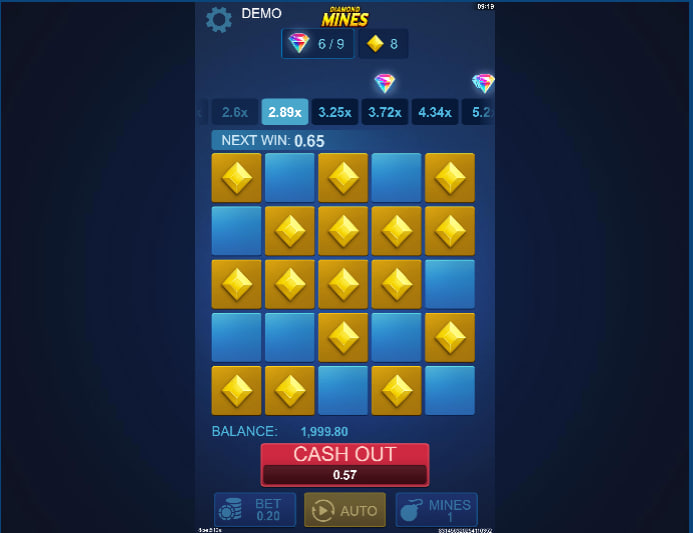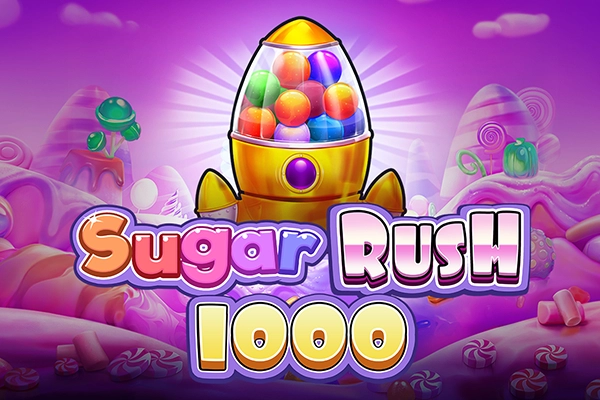Diamond Mines by Yellow Bat delivers a strategic instant win experience distinct from traditional slots. Its atmosphere is one of stark minimalism, focusing entirely on a central risk-versus-reward mechanic. The game unfolds on a 5×5 grid where the primary objective is to select tiles to reveal gems. Each uncovered gem advances the player up a progressive multiplier ladder, creating mounting tension. The core of the game is its innovative player-controlled volatility, allowing you to set the number of hidden mines before each round. This directly impacts the potential reward scale. The primary bonus is the Rainbow Diamond feature, which is awarded for collecting a specific number of gems in a round. This feature dynamically increases the value of all subsequent multipliers, adding a significant strategic layer to the gameplay.
Diamond Mines by Yellow Bat presents itself not as a traditional video slot, but as a calculated exercise in risk management. Its aesthetic is one of stark minimalism; there are no elaborate backdrops, animated characters, or branching narratives. The interface is clean, functional, and resembles a strategic tool more than a cinematic game. This design choice is deliberate, stripping away all thematic distractions to focus the player’s attention squarely on the central mechanic: a pure and direct confrontation with probability.
The game’s arena is an unassuming 5×5 grid of 25 identical tiles. The objective is elementary in concept but complex in execution: select tiles to reveal gems while avoiding hidden mines. It is a modern interpretation of the classic Minesweeper computer game, repurposed as a real-money gaming format. The experience is less about spinning reels and more about making a series of deliberate, pressure-filled decisions where each click carries the full weight of the round's potential success or immediate failure.

Core Gameplay Mechanics
Before any bet is committed, the player must make the single most influential decision of the round: setting the number of mines on the grid. This function, adjustable from a single mine up to a significant portion of the 25 tiles, is the game’s primary control mechanism. It directly dictates the mathematical reality of the session. Opting for fewer mines creates a scenario with a higher probability of success on each pick, but the corresponding rewards, represented by a multiplier ladder, increase at a modest pace. Conversely, seeding the grid with many mines creates a high-risk environment where each successful pick is statistically less likely but yields a far more aggressive escalation in payout multipliers.
This structure puts the game’s volatility directly into the player's hands. Unlike traditional slots where volatility is a fixed attribute set by the developer, here it becomes a strategic choice. Player-controlled volatility is the defining characteristic of Diamond Mines. A player can shift from a low-variance grind to a high-variance chase for a jackpot-level payout between any two rounds. Once the bet and mine count are set, the round begins. Each tile selection results in one of two outcomes: a yellow gem, which progresses the player along the multiplier ladder, or a mine, which instantly terminates the round and forfeits the accumulated winnings for that round.
The Multiplier System and Symbol Functions
The mine symbol is the instrument of failure. It is the stop sign, the end of the road for the current round’s wager. There is no nuance to its function—revealing it results in a total loss of the stake and any unrealized gains from that specific game. This binary outcome is what generates the game's tension. Complementing these symbols is the most important button on the screen: “Cash Out.” At any point after revealing at least one gem, the player can use this function to end the round voluntarily and collect the winnings associated with their current multiplier. This creates a constant psychological dilemma between securing a known profit and risking it for a greater, but uncertain, future gain.

The Rainbow Diamond: A Strategic Modifier
The game's primary strategic layer is introduced through the Rainbow Diamond. This is not a symbol found on the grid itself. Instead, it is an award granted to the player for achieving a specific milestone within a single round. The bar above the grid indicates how many yellow gems must be collected consecutively to earn a Rainbow Diamond. For example, the game might require collecting 9 gems to be awarded the first one.
Upon receiving a Rainbow Diamond, its effect is immediate and powerful: it randomly increases all subsequent, unreached win multipliers on the ladder for the current round. This is a critical mechanic. It transforms the game from a linear progression into one with dynamic potential. Furthermore, this bonus can be awarded multiple times in a single round, with each new Rainbow Diamond further enhancing the remaining multipliers. This creates compelling strategic scenarios. A player might be tempted to cash out at a 5x multiplier but notice that the next gem find would award a Rainbow Diamond. The calculated risk of pushing for that one additional gem could transform the next potential multipliers from 6x and 7x to perhaps 9x and 12x, fundamentally altering the risk/reward equation for the remainder of the round.
Diamond Mines is a finely tuned instrument for a specific type of player. It intentionally sheds the narrative and visual complexity of modern video slots to offer a pure, mechanics-driven experience. The game is an arena for those who appreciate probability, risk assessment, and direct agency over their gameplay variance. It is a game of nerve, where the most significant opponent is one's own appetite for risk.
This title is highly recommended for experienced players who find themselves drawn to crash games or other formats where strategic decision-making and volatility control are paramount. If your enjoyment comes from analyzing odds, managing a risk budget, and the psychological tug-of-war of a “cash out” decision, Diamond Mines is a superior example of its genre. The addition of the Rainbow Diamond modifier provides a welcome layer of strategic depth that elevates it above more basic Mines implementations.
However, players seeking immersive themes, diverse bonus features like free spins or pick-me games, or a more relaxed, passive gaming session will likely find the experience sterile. Diamond Mines makes no apologies for what it is: a sharp, focused, and intellectually demanding game of chance and strategy. For the right audience, it is an exceptionally well-executed concept.













